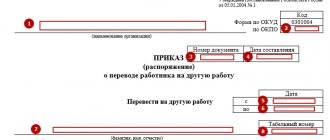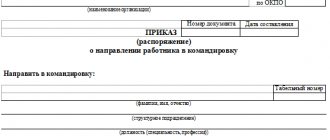During the period of work at the enterprise, its employees can be transferred from one position to another. This can happen for completely different reasons: promotion and demotion, the vacancy of a vacancy, the employee acquiring a new specialty, for medical reasons, etc. Regardless of what circumstances served as the reason for such a rearrangement, this action must be formalized properly. One of the main documents that accompany the transfer of an employee from one position to another within the organization is the manager’s order to transfer to another job in the T-5 form:
- Form and sample
- Online viewing
- Free download
- Safely
FILES
An important clarification: if any changes occur in the name of an employee’s position in the process of carrying out his activities, but the essence of the job functions performed remains the same, there is no need to draw up a transfer order.
What is the basis for the order?
Orders issued by company management must always have a basis. In this case, it may be a statement written on behalf of the employee himself (with justification for this desire) or a memorandum from the head of the structural unit, which must indicate compelling arguments for carrying out this procedure. If the transfer occurs at the initiative of the employer, then the employee must first be notified of the upcoming changes in his career.
The difference between translation and displacement
Transfers and movements are regulated by Art. 72.1 TK. A transfer is a revision of the defining terms of an employment contract:
- change in the employee’s work activity;
- change of place of work (branch, division) specified in the agreement between the employer and employee;
- moving together with the management of the enterprise to another region.
| Advice It is possible to dismiss an employee by transferring to another organization - Article 72.1. At his request, a transfer to another employer is made, and the employment contract at the old place of work is canceled. |
An enterprise can have internal and external (located separately) structural divisions. Separateness is determined by an address different from the location of the parent organization.
| Important! The concept of “structural unit” is given by the Plenum of the Supreme Court in the Resolution of March 17, 2004 No. 2, paragraph 16. These are not only branches and representative offices, but also departments, workshops, and areas. The concept of “other locality” is determined by the boundaries of the locality in which the organization is located. |
A new appointment can be made only after the employee’s written consent to the transfer, if the agreement with the employer specifies the place of work and it changes. There are exceptions, Art. 72.2 - without consent, you can transfer an employee to another job in cases of:
- exceptional circumstances requiring the prevention or elimination of the consequences of an emergency;
- downtime due to emergency circumstances or suspension of work for economic or other reasons.
The same article talks about the rules of temporary transfer for a period of up to 1 year or until the main employee leaves in case of his replacement.
The nature of the work becomes permanent if, after the employee’s transfer, the period has ended and the parties have not indicated an intention to return to the previous conditions.
If the place of work is not specified in the employment agreement, this will not be a transfer at the initiative of the employer; it is formalized in accordance with Art. 72.1.
| Important! It is prohibited to move to another structural unit if the transfer is related to work that is contraindicated for the employee due to his health. |
Basic rules for placing an order
Today, the law says that an order to transfer an employee from one position to another can be issued in a free form. However, many enterprises and organizations, in the old fashioned way, prefer to use the previously approved and widespread T-5 form. This is understandable: the form contains all the necessary data, including information about the employer and subordinate, information about the former and new place of work, reasons for the transfer, etc.
The order can be filled out either by hand or on a computer, but it is printed out in a single copy and, after writing, is given first to the manager for signature, and then for review to the employee for whom it was drawn up. His autograph on the document will indicate that he agrees with the transfer to a certain position with the designation of a specific tariff rate and other conditions.
After registration, the order must be registered in the internal document register, and then transferred for storage to the personnel department.
Entry into the work book
The law does not provide for the inclusion in work books of notes about cases of transfers of this kind.
A situation may arise when a person worked, for example, as a manager as a temporary transfer, and he needs to confirm this fact for further employment.
To confirm his experience, the employee can use a copy of the order for his transfer or an additional agreement to the contract.
Situations often arise when an employee remains to work in a new place even after the end of the temporary transfer period. It turns out that the employee will actually work in a new position from one date, and the information in the work book will be entered when the order for permanent transfer is issued. Some HR specialists deal with this situation as follows:
- in column 3, where the unit and position are indicated, they also write the date from which the temporary transfer was made;
- in column 4, reference is made to both orders of the director of the legal entity, approving both temporary and permanent transfer.
An example of filling out an order to transfer an employee to another job using the T-5 form
The standard sample in the T-5 form is quite simple and should not cause any difficulties during registration.
The first part of the T-5 form
The first part of the document indicates the full name of the organization, the OKPO code (in accordance with the registration papers), as well as its internal document flow number and the date of its preparation. Below is the period during which the employee will work in another position.
- If the transfer is temporary, then the start date and end date of the work (if the latter is known) should be indicated.
- If the transfer is made on an ongoing basis, then you only need to set the date from which the employee will be obliged to begin his new duties.
In addition, with a permanent transfer, information about it must be entered into the work book and the employee’s personal file, as well as an additional agreement to the employment contract must be drawn up with him (on changes in working conditions and other parameters).
Next, you should enter the employee’s last name, first name, patronymic, his personnel number (if such records are kept at the enterprise), and also indicate the type of transfer.
The second part of the T-5 form
In the second part of the document, information about the employee’s previous place of work is first entered, namely the structural unit where he worked and his position (in accordance with the staffing table). In the next line you need to indicate the reason for the transfer.
The second table contains information about the new location:
- department name,
- job title,
- as well as the size of the tariff rate and all possible allowances due to the employee.
Next, you need to provide a link to the documents that served as the basis for issuing the order: usually this is either a statement from the employee or a memo from his immediate superior. If the transfer is caused by some other factors (for example, an employee’s illness), then data from the supporting document (for example, a medical report) must be entered here.
Finally, the order should be given to the employee for review. Without his signature, the document will have no legal significance.
We arrange the transfer of an employee
If a division or subsidiary is located in another region, this must be indicated in the agreement with the employee. In this case, the transfer will be carried out only when the employee expresses his desire and consent to it.
| If the employment contract does not indicate the location of the branch, this is a violation of the Labor Code. The appointment of an employee to a unit located in another city (locality), even if the other terms of the employment agreement do not change, is always formalized as a transfer. |
Step-by-step procedure for transferring an employee at the initiative of the employer:
- The employer notifies the employee of the transfer indicating the reasons. The employee expresses consent or disagreement in a separate document or in the text of the notice. When assigned to another location by the employer, an application for transfer from the employee is not required.
| Example I have read the notice and received a copy. or In response to your proposal dated December 10, 2020, I agree to the transfer to the “Name” branch located in Akhtubinsk. |
- Changes are recorded in an additional labor agreement. Here you can also prescribe the procedure for compensating an employee for his travel expenses (Article 169 of the Labor Code).
- The next step in a transfer initiated by the employer is the issuance of an order. The unified form T-5 or T-5a is used. You can use your own document forms if they are developed and approved by the LNA.
- Based on the order, the HR department specialist makes an entry in the work book, in a personal card in the T-2 form.
A transfer without the consent of the employee is unacceptable - dismissal is possible only if the employee refused to move with the employer (clause 9 of Article 77 of the Labor Code).
When you can’t and when you can refuse a transfer
There are situations in which the employer does not have the right to refuse to transfer an employee to another position: this is the employee’s pregnancy and the presence of young children, the presence of medical indications, etc. But, for example, a transfer due to staff reduction or to another location at the initiative of the organization is possible only with the personal written consent of the employee.
The employee himself can, at any time and for any reason, refuse a transfer initiated by the employer, and also demand that he be provided with another, more suitable position, with working conditions that suit him.
Purpose of the document
Compiled in cases where an employee is transferred to a new position (within the same company). Transfer may be due to various reasons:
- moving to another region (to work in a branch or at the company’s head office);
- replacing another employee (for example, due to long sick leave);
- transfer to a new department due to the reorganization of structural divisions, etc.
An employee can switch to either permanent or temporary work - the content and form do not change.
Conclusion
Temporary transfer involves transferring an employee to perform another job for a certain period.
After completion of this period, he returns to his previous job, or the transfer becomes permanent. The transfer time should not exceed 1 year, except in cases where the transfer is made to a temporarily vacant position. You can find more complete information on the topic in ConsultantPlus. Free trial access to the system for 2 days.
Temporary transfer to another job without the employee’s consent
The Labor Code of the Russian Federation provides a list of factors and conditions under which an employee can be transferred without his consent:
- in the event of natural and man-made disasters, as well as other factors that pose a risk to the life and health of surrounding people;
- in case of downtime, as well as to eliminate the risk of damage and loss of property, if these circumstances were caused by the factors given above.
Such a transfer can be carried out for a period not exceeding 1 month.
Temporary transfer of an employee to replace an absent employee
The case when a temporary transfer is carried out to a staff unit that already has an employee, but is temporarily absent, is stipulated separately in the legislation. In this case, the transfer period is limited not to 1 year, but to the time of absence of the main employee. Accordingly, it may exceed the specified 12 months. For example, you can make a temporary transfer for three years if the employee went on maternity leave.
The registration procedure will be the same as in the previous case.
Note! In the case of transfer to the place of an absent employee, it is better not to put a specific date as the end date, but to indicate the event that will mark the end of the transfer period. For example: “The transfer is carried out from October 1, 2017 until the end of the period of incapacity for work and the return to work of manager A.V. Yesenina.”
Documenting
The procedure for processing a transfer depends on whether the personnel event is permanent or temporary.
For a certain period
In this case, the first step is to obtain the written consent of the person who intends to transfer (if such consent is required by law). If the subordinate does not object to temporarily performing duties not provided for by his employment contract, then the director issues an order to transfer the person to another job.
When preparing an order, you must use the unified form T-5. The form must include:
- information about the employee who is being transferred;
- information about the old and new positions;
- information regarding the reason for the transfer.
The order also specifies the type of transition to a new job, which in this situation is temporary. In addition, boundary dates must be set - the first and last day of performing new duties. If it is difficult to predict the completion date of the transfer in advance, you need to provide a reference to the relevant event, for example, before the main employee returns to work.
The manager signs the completed order and provides it to the employee for review.
A temporary transfer is not reflected in the employee’s work book.
If an employee is involuntarily transferred due to emergency circumstances, he must be given a corresponding notice indicating the period of transfer and its basis.
Permanently
If a new position is provided on a permanent basis, the application procedure becomes a little more complicated. As in the case of a temporary transfer, it is first necessary to obtain the consent of the person whose working conditions are planned to be changed. If the latter does not object to new responsibilities, the employer and the hired person enter into an additional agreement, which is an integral part of the employment contract.
This document records all the conditions for the transition to a new position, in particular, a description of the new job function, as well as all changes regarding:
- places of work;
- work and rest schedule;
- the amount of remuneration and other important conditions.
Next, a transfer order is issued. The same single approved form T-5 is used. The order must state that the transition to a new job is permanent.
In this case, the order is the basis for making appropriate entries in the work book and personal card of the subordinate.
Let us remind you that in the case of a temporary transfer, an entry is not made in the work book.
In practice, there are cases when the initiator of a transfer to another position can be the employee himself or his immediate superior. If an employee intends to transfer to the same organization of his own free will, he should write an application with a corresponding request addressed to the manager.
The application must indicate the reasons for the personnel reshuffle, for example, “Please transfer me to the position of deputy manager due to the presence of an open vacancy and the availability of the necessary experience and knowledge to fill it.”
If the initiator of the transfer is the immediate manager, he must prepare a proposal for the transfer of his specialist to the general director. The submission must indicate the following:
- Translation proposal.
- Description of the vacant position.
- Information about the candidate for the position, including characteristics of his professional qualities, education, work experience.








